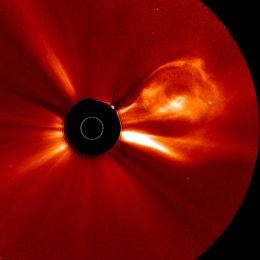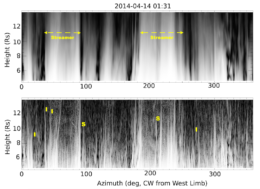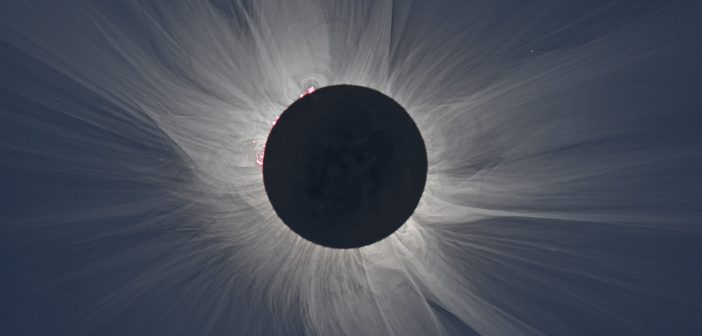The hot, tenuous solar corona is visible during a total solar eclipse, and astronomers have long studied the structure and dynamics of the ghostly coronal streamers. Now, a special observing campaign has allowed us to see the corona in unprecedented detail.

NASA’s STEREO has observed the solar atmosphere and solar wind — including coronal mass ejections like the one pictured here — for over a decade. [NASA/STEREO]
A STEREO View
Despite the wealth of knowledge we’ve amassed about our nearest star, there is still a lot we don’t know about the corona — the uppermost region of the solar atmosphere. Previous observations of the outer corona have indicated that the region is smooth and lacking in small-scale structure — but is it really?
To learn more about the outer corona, a team led by Craig DeForest (Southwest Research Institute) analyzed images from a special observing campaign by NASA’s Solar Terrestrial Relations Observatory-A (STEREO-A). In a departure from its typical observing mode, STEREO-A increased its imaging cadence by a factor of four and exposure time by a factor of six. Using careful image-processing techniques, DeForest and collaborators extracted hidden details from the STEREO-A images.

Left: An unprocessed image from the STEREO-A campaign. Right: The same frame with stray light and the F-corona (sunlight scattered off of dust grains) removed. Click to enlarge. [DeForest et al. 2018]
An Eye for Detail
The authors found that the seemingly smooth outer corona is made up of small-scale filamentary substructures that are visible down to the resolution limit of the instrument — corresponding to approximately 20,000 km.
These dense, narrow filaments might arise due to the dynamics of the corona itself, but it’s also possible that each filament can be traced back to an individual granule on the solar photosphere. This has exciting implications for future observations, which may be able to capture changes in the corona that correspond to changes in the granulation pattern on the solar surface.
The observed density variations also have consequences for how the solar wind is generated. The boundary between the solar atmosphere and the solar wind is often taken to be the Alfvén surface, where the radial velocity of the solar plasma exceeds the Alfvén speed — the speed at which hydrodynamic waves travel in a magnetized plasma. Because the Alfvén speed is a function of the plasma density, these extreme density variations over small spatial scales imply that the Alfvén surface is less of a discrete level in the solar atmosphere and more of a broad zone over which the coronal plasma gradually disconnects from the Sun and begins to flow outward as the solar wind.

Top: An image of the corona in polar coordinates. Bottom: The same region, highlighting the locations of sharp brightness gradients. Click to enlarge. [DeForest et al. 2018]
Ready for Its Close-up
Luckily, we’ll have the opportunity to examine the intricate structure in the outer corona up close. DeForest and collaborators predict that NASA’s Parker Solar Probe, which will travel through the outer corona, will be able to discern the small-scale structures they discovered in the STEREO images. The spacecraft may observe changes in the density of the coronal plasma of up to an order of magnitude over the span of just ten minutes.
We won’t have to wait long to find out — launched in August 2018, Parker Solar Probe will have its first close encounter with the Sun in November 2018. By 2025, the spacecraft will be sampling the coronal plasma less than 10 solar radii above the solar photosphere.
Citation
C. E. DeForest et al 2018 ApJ 862 18. doi:10.3847/1538-4357/aac8e3


3 Comments
Pingback: AAS Nova – New
Pingback: A New Look at the Solar Corona – CityGov
Pingback: A New Look at the Solar Corona – AstroBrief